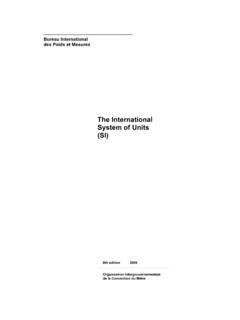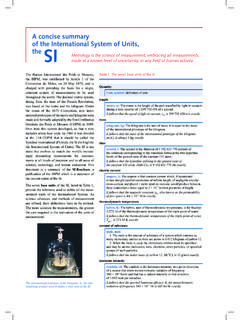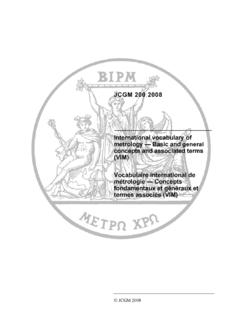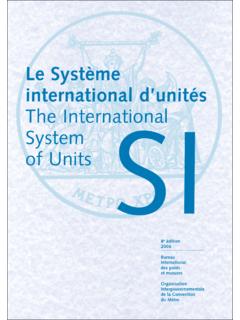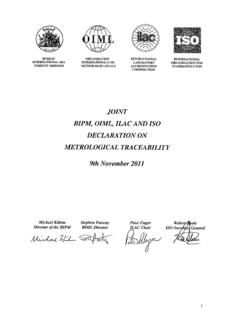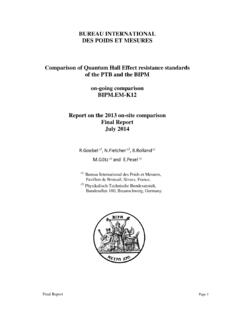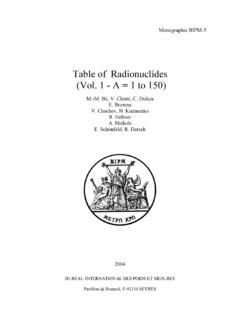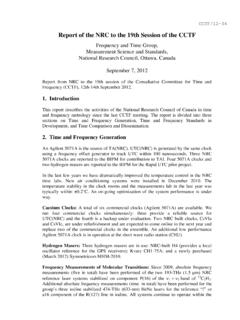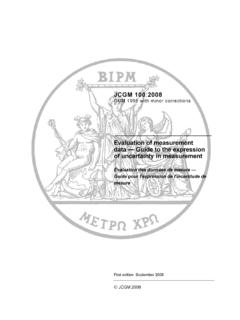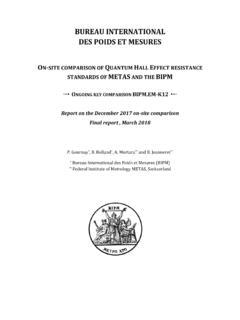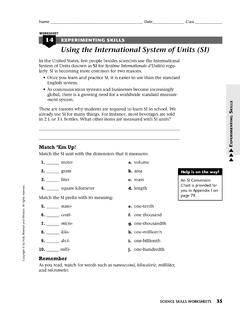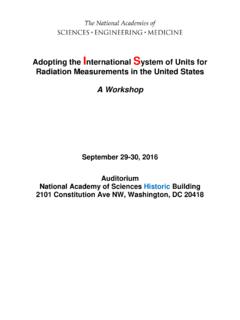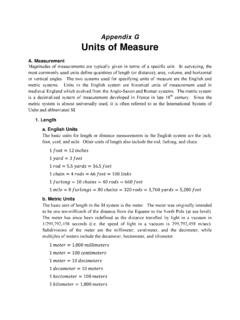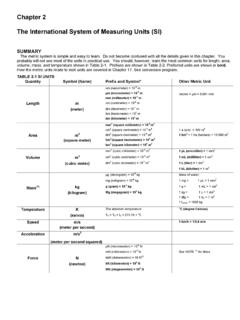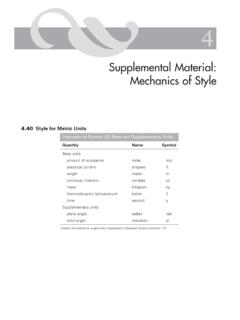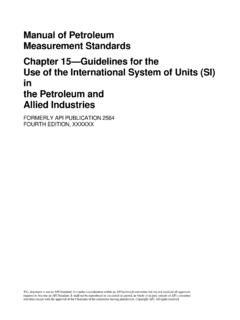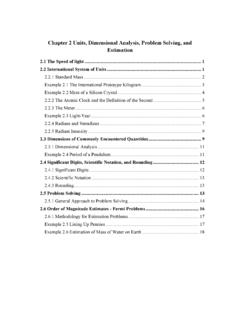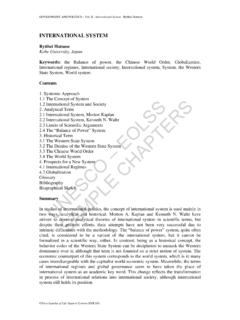Transcription of The International System of Units (SI) - BIPM
1 Bureau International des Poids et Mesures The International System of Units (SI) 9th edition 2019 2 Draft of the ninth SI Brochure, 18 December 2018 The BIPM and the Metre Convention The International Bureau of Weights and Measures (BIPM) was set up by the Metre Convention signed in Paris on 20 May 1875 by seventeen States during the final session of the diplomatic Conference of the Metre. This Convention was amended in 1921. The BIPM has its headquarters near Paris, in the grounds (43 520 m2) of the Pavillon de Breteuil (Parc de Saint-Cloud) placed at its disposal by the French Government; its upkeep is financed jointly by the Member States of the Metre Convention. The task of the BIPM is to ensure worldwide unification of measurements; its function is thus to: establish fundamental standards and scales for the measurement of the principal physical quantities and maintain the International prototypes; carry out comparisons of national and International standards; ensure the coordination of corresponding measurement techniques; carry out and coordinate measurements of the fundamental physical constants relevant to these activities.
2 The BIPM operates under the exclusive supervision of the International Committee for Weights and Measures (CIPM) which itself comes under the authority of the General Conference on Weights and Measures (CGPM) and reports to it on the work accomplished by the BIPM. Delegates from all Member States of the Metre Convention attend the General Conference which, at present, meets every four years. The function of these meetings is to: discuss and initiate the arrangements required to ensure the propagation and improvement of the International System of Units (SI), which is the modern form of the metric System ; confirm the results of new fundamental metrological determinations and various scientific resolutions of International scope; take all major decisions concerning the finance, organization and development of the BIPM. The CIPM has eighteen members each from a different State: at present, it meets every year.
3 The officers of this committee present an annual report on the administrative and financial position of the BIPM to the Governments of the Member States of the Metre Convention. The principal task of the CIPM is to ensure worldwide uniformity in Units of measurement. It does this by direct action or by submitting proposals to the CGPM. As of 20 May 2019, fifty nine States were Members of this Convention: Argentina, Australia, Austria, Belgium, Brazil, Bulgaria, Canada, Chile, China, Colombia, Croatia, Czech Republic, Denmark, Egypt, Finland, France, Germany, Greece, Hungary, India, Indonesia, Iran (Islamic Rep. of), Iraq, Ireland, Israel, Italy, Japan, Kazakhstan, Kenya, Korea (Republic of), Lithuania, Malaysia, Mexico, Montenegro, Netherlands, New Zealand, Norway, Pakistan, Poland, Portugal, Romania, Russian Federation, Saudi Arabia, Serbia, Singapore, Slovakia, Slovenia, South Africa, Spain, Sweden, Switzerland, Thailand, Tunisia, Turkey, Ukraine, United Arab Emirates, United Kingdom, United States of America, and Uruguay.
4 Forty-two States and Economies were Associates of the General Conference: Albania, Azerbaijan, Bangladesh, Belarus, Bolivia, Bosnia and Herzegovina, Botswana, CARICOM, Chinese Taipei, Costa Rica, Cuba, Ecuador, Estonia, Ehiopia, Georgia, Ghana, Hong Kong (China), Jamaica, Kuwait, Latvia, Luxembourg, Macedonia (fmr Yugoslav Rep. of), Malta, Mauritius, Moldova (Republic of), Mongolia, Namibia, Oman, Panama, Paraguay, Peru, Philippines, Qatar, Seychelles, Sri Lanka, Sudan, Syrian Arab Republic, Tanzania (United Republic of), Viet Nam, Zambia, and Zimbawe Draft of the ninth SI Brochure, 18 December 2018 3 The activities of the BIPM, which in the beginning were limited to measurements of length and mass, and to metrological studies in relation to these quantities, have been extended to standards of measurement of electricity (1927), photometry and radiometry (1937), ionizing radiation (1960), time scales (1988) and to chemistry (2000).
5 To this end the original laboratories, built in 1876 -1878, were enlarged in 1929; new buildings were constructed in 1963-1964 for the ionizing radiation laboratories, in 1984 for the laser work and in 1988 for a library and offices. In 2001 a new building for the workshop, offices and meeting rooms was opened. Some forty-five physicists and technicians work in the BIPM laboratories. They mainly conduct metrological research, International comparisons of realizations of Units and calibrations of standards. An annual report, the Director s Report on the Activity and Management of the International Bureau of Weights and Measures, gives details of the work in progress. Following the extension of the work entrusted to the BIPM in 1927, the CIPM has set up bodies, known as Consultative Committees, whose function is to provide it with information on matters that it refers to them for study and advice.
6 These Consultative Committees, which may form temporary or permanent working groups to study special topics, are responsible for coordinating the International work carried out in their respective fields and for proposing recommendations to the CIPM concerning Units . The Consultative Committees have common regulations (BIPM Com. Int. Poids et Mesures, 1963, 31, 97). They meet at irregular intervals. The president of each Consultative Committee is designated by the CIPM and is normally a member of the CIPM. The members of the Consultative Committees are metrology laboratories and specialized institutes, agreed by the CIPM, which send delegates of their choice. In addition, there are individual members appointed by the CIPM, and a representative of the BIPM (Criteria for membership of Consultative Committees, BIPM Com. Int. Poids et Mesures, 1996, 64, 124). At present, there are ten such committees: 1.
7 The Consultative Committee for Electricity and Magnetism (CCEM), new name given in 1997 to the Consultative Committee for Electricity (CCE) set up in 1927; 2. The Consultative Committee for Photometry and Radiometry (CCPR), new name given in 1971 to the Consultative Committee for Photometry (CCP) set up in 1933 (between 1930 and 1933 the CCE dealt with matters concerning photometry); 3. The Consultative Committee for Thermometry (CCT), set up in 1937; 4. The Consultative Committee for Length (CCL), new name given in 1997 to the Consultative Committee for the Definition of the Metre (CCDM), set up in 1952; 5. The Consultative Committee for Time and Frequency (CCTF), new name given in 1997 to the Consultative Committee for the Definition of the Second (CCDS) set up in 1956; 6. The Consultative Committee for Ionizing Radiation (CCRI), new name given in 1997 to the Consultative Committee for Standards of Ionizing Radiation (CCEMRI) set up in 1958 (in 1969 this committee established four sections: Section I (X- and -rays, electrons), Section II (Measurement of radionuclides), Section III (Neutron measurements), Section IV ( -energy standards); in 1975 this last section was dissolved and Section II was made responsible for its field of activity); 4 Draft of the ninth SI Brochure, 18 December 2018 7.
8 The Consultative Committee for Units (CCU), set up in 1964 (this committee replaced the Commission for the System of Units set up by the CIPM in 1954); 8. The Consultative Committee for Mass and Related Quantities (CCM), set up in 1980; 9. The Consultative Committee for Amount of Substance: Metrology in Chemistry and Biology (CCQM), set up in 1993; 10. The Consultative Committee for Acoustics, Ultrasound and Vibration (CCAUV), set up un 1999. The proceedings of the General Conference and the CIPM are published by the BIPM in the following series: Report of the meeting of the General Conference on Weights and Measures; Report of the meeting of the International Committee for Weights and Measures. The CIPM decided in 2003 that the reports of meetings of the Consultative Committees should no longer be printed, but would be placed on the BIPM website, in their original language. The BIPM also publishes monographs on special metrological subjects and, under the title The International System of Units (SI), this brochure, periodically updated, in which are collected all the decisions and recommendations concerning Units .
9 The collection of the Travaux et M moires du Bureau International des Poids et Mesures (22 volumes published between 1881 and 1966) and the Recueil de Travaux du Bureau International des Poids et Mesures (11 volumes published between 1966 and 1988) ceased by a decision of the CIPM. The scientific work of the BIPM is published in the open scientific literature and an annual list of publications appears in the Director s Report on the Activity and Management of the International Bureau of Weights and Measures. Since 1965 Metrologia, an International journal published under the auspices of the CIPM, has printed articles dealing with scientific metrology, improvements in methods of measurement, work on standards and Units , as well as reports concerning the activities, decisions and recommendations of the various bodies created under the Metre Convention. Draft of the ninth SI Brochure.
10 18 December 2018 5 The International System of Units Contents The BIPM and the Metre Convention 2 Preface to the 9th edition 7 1 Introduction 8 The SI and the defining constants 8 Motivation for the use of defining constants to define the SI 8 Implementation of the SI 9 2 The International System of Units 10 Defining the unit of a quantity 10 Definition of the SI 10 The nature of the seven defining constants 11 Definitions of the SI Units 12 Base Units 13 Practical realization of SI Units 18 Dimensions of quantities 19 Derived Units 20 Units for quantities that describe biological and physiological effects 24 SI Units in the framework of the general theory of relativity 24 3 Decimal multiples and sub-multiples of SI Units 26 4 Non-SI Units that are accepted for use with the SI 28 5 Writing unit symbols and names, and expressing the values of quantities 30 The use of unit symbols and names 30 unit symbols 30 unit names 31 Rules and style conventions for expressing values of quantities 31 Value and numerical value of a quantity, and the use of quantity calculus 31 Quantity symbols and unit symbols 32 Formatting the value of a quantity 32 Formatting numbers, and the decimal marker 33 Expressing the measurement uncertainty in the value of a quantity 33 Multiplying or dividing quantity symbols, the values of quantities, or numbers 33 Stating quantity values being pure numbers 34 Plane angles, solid angles and phase angles 34 6 Draft of the ninth SI Brochure, 18 December 2018 Appendix 1.
